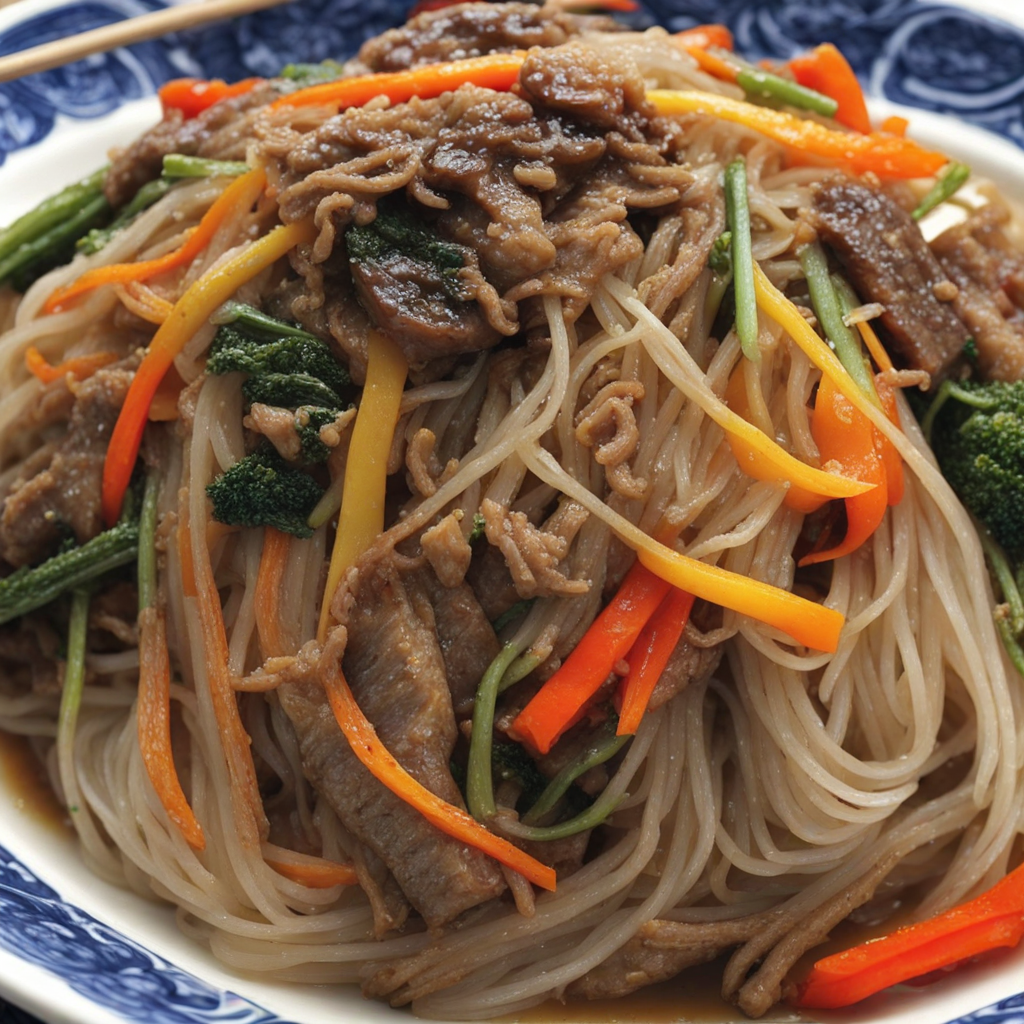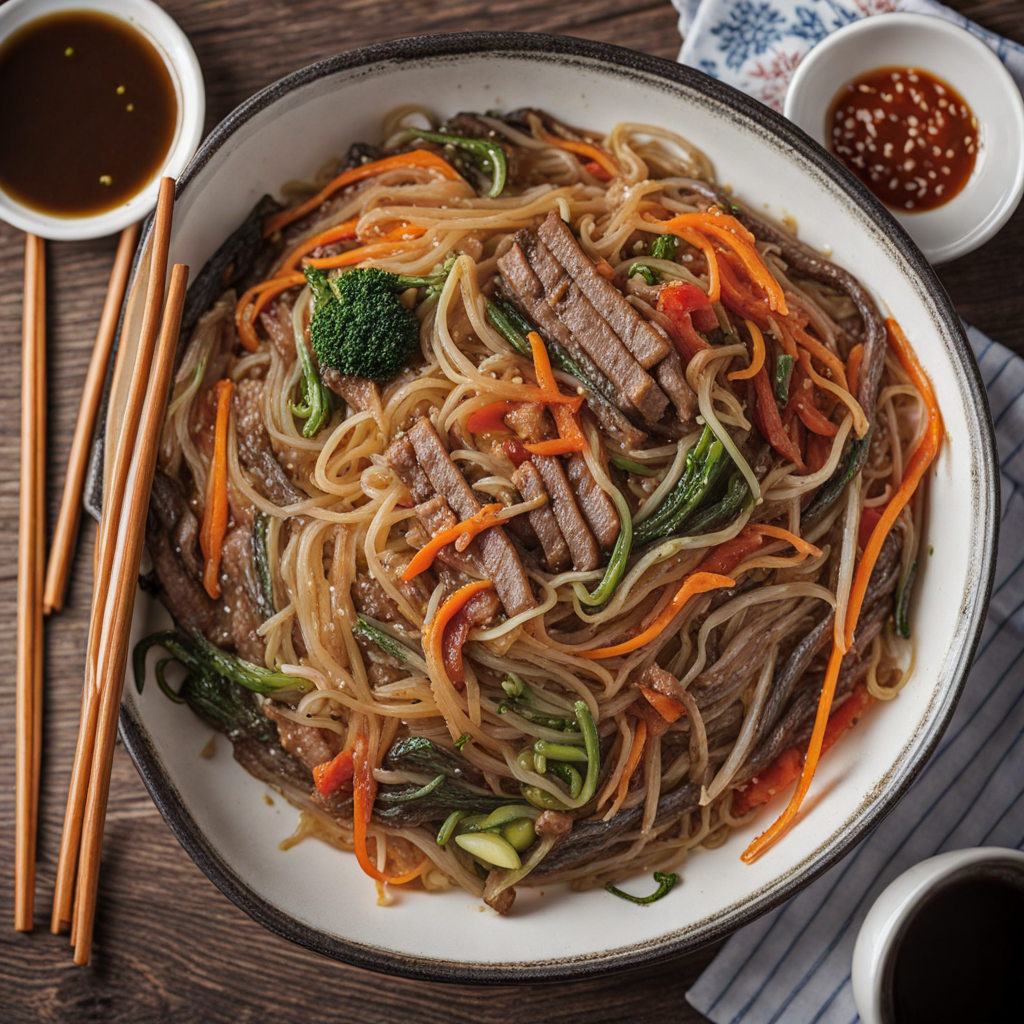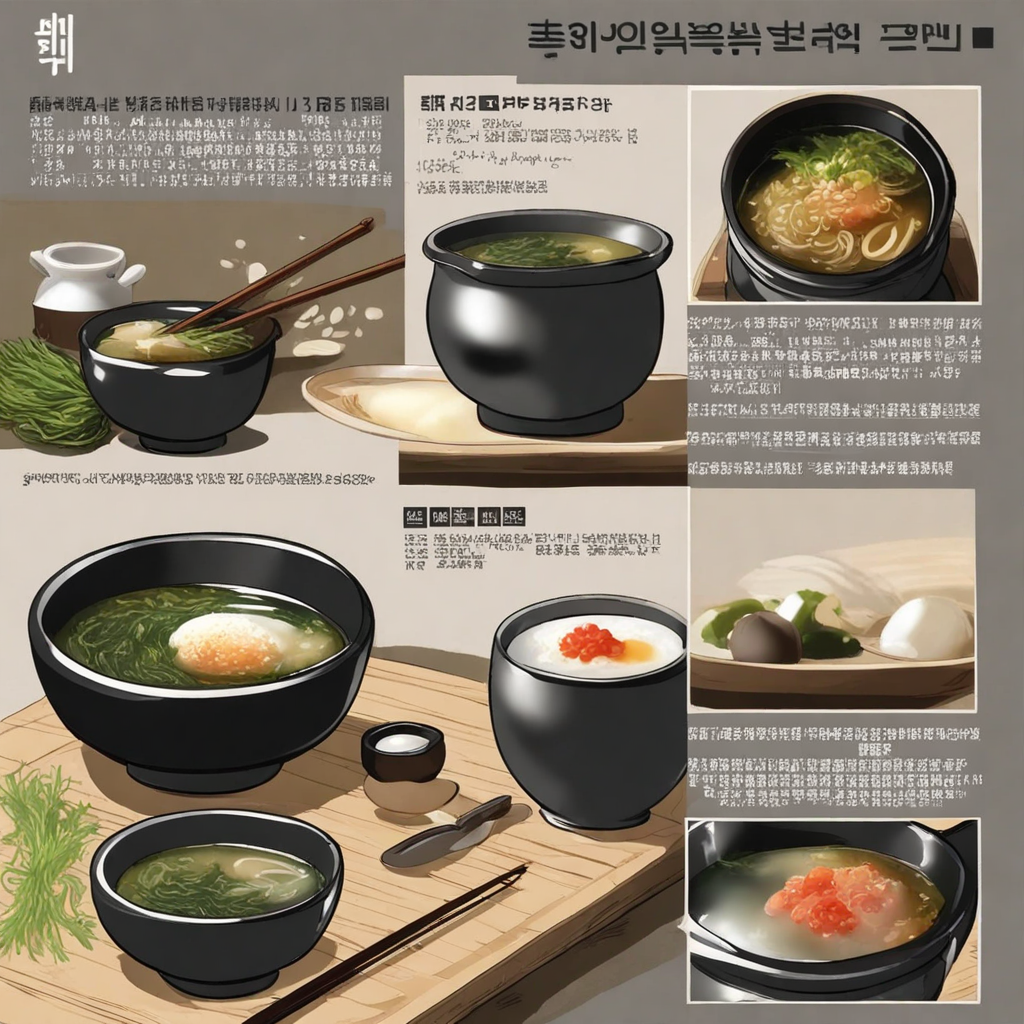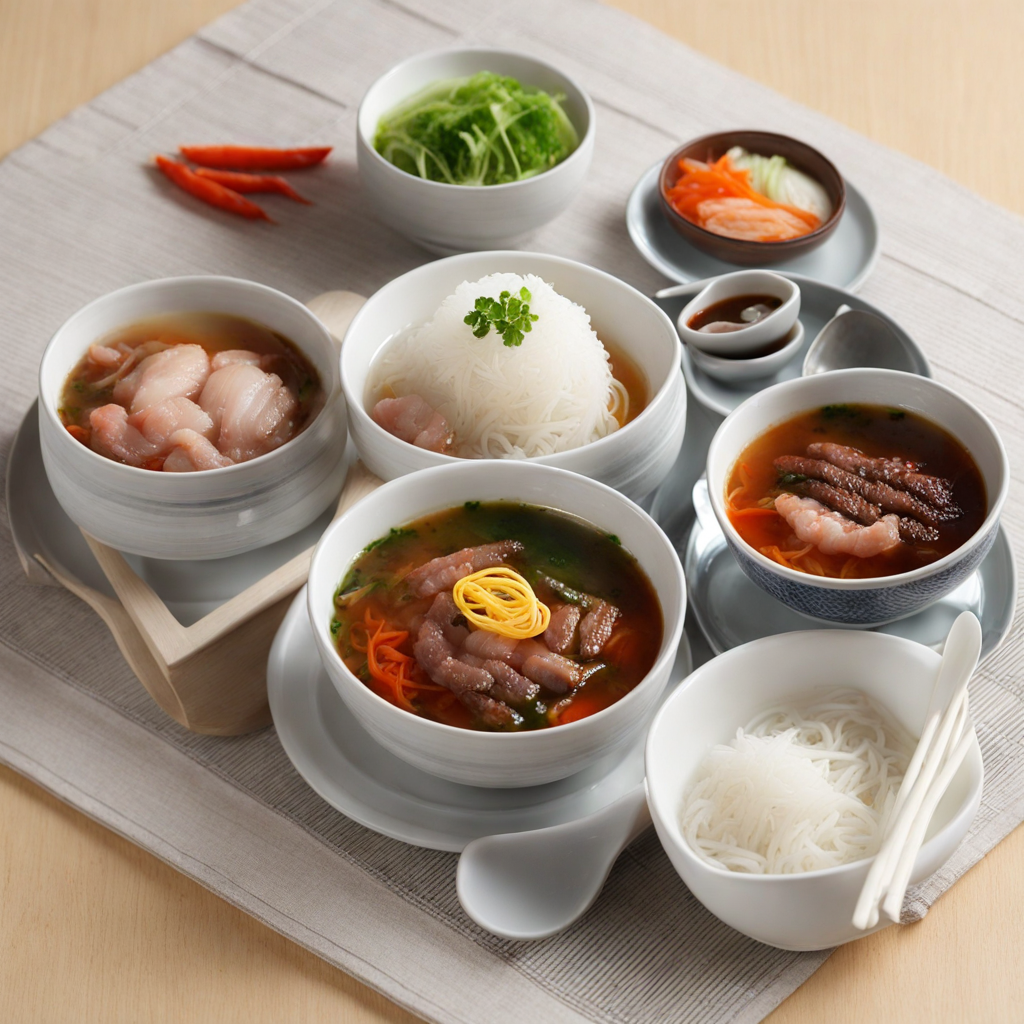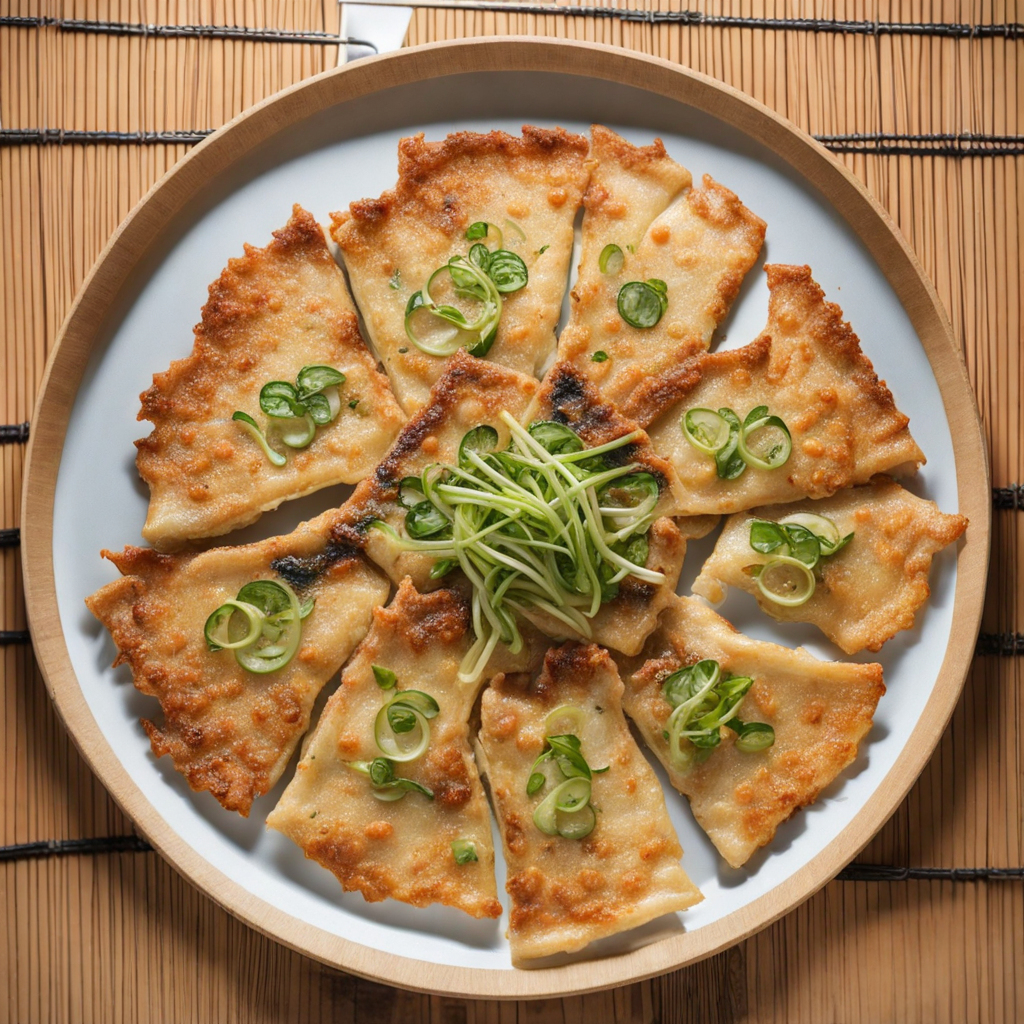Japchae
Japchae is a traditional Korean dish that boasts a delightful combination of textures and flavors, making it a must-try for anyone looking to explore new culinary experiences. At its core, japchae features sweet potato starch noodles, known as 'dangmyeon', which are cooked to a chewy perfection. These translucent noodles serve as the base of the dish, offering a unique mouthfeel that sets japchae apart from other noodle dishes. The noodles are typically stir-fried with a medley of colorful vegetables such as carrots, spinach, and bell peppers, which not only enhance the visual appeal but also contribute a fresh crunch and vibrant flavor profile to each bite. Beyond the noodles and vegetables, japchae is often enriched with thinly sliced beef or other proteins, marinated in a sweet and savory sauce made from soy sauce, sesame oil, and sugar. This marinade infuses the ingredients with a rich umami flavor, allowing each component to shine while harmonizing beautifully with the others. The dish is usually garnished with sesame seeds, adding a nutty aroma and a touch of elegance, making it a feast for both the eyes and the palate. Japchae is versatile and can be enjoyed as a main dish or a side, served hot or at room temperature, making it a popular choice for gatherings and celebrations. Its sweet, savory, and slightly smoky flavors, combined with the satisfying chewiness of the noodles, create a memorable dining experience. Whether you're a seasoned fan of Korean cuisine or a newcomer eager to explore, japchae offers a delicious journey into the heart of South Korea's culinary traditions.
How It Became This Dish
Origin of 잡채 잡채, pronounced "japchae," is a beloved dish in South Korean cuisine that has captured the hearts and taste buds of many both within the nation and around the globe. The origins of 잡채 date back to the 17th century during the Joseon Dynasty. It was initially prepared for special occasions, particularly for nobility and royal banquets. The dish was created by chefs who sought to combine various ingredients that would not only taste good but also showcase the artistry of Korean cooking. Early versions of 잡채 were quite different from what we know today, often featuring a variety of meats and seasonal vegetables, sometimes flavored with expensive spices. The name "japchae" can be translated to "mixed vegetables," which reflects the dish's core concept: a harmonious blend of ingredients. The dish is primarily made with sweet potato starch noodles, known as "dangmyeon," which are chewy and elastic in texture. These noodles are stir-fried with an array of vegetables, such as carrots, spinach, and shiitake mushrooms, along with sesame oil and soy sauce, creating a visually appealing and flavorful meal. \n Cultural Significance Over the centuries, 잡채 evolved from a noble dish to a staple in South Korean households, representing comfort and celebration. It is commonly served during festive occasions such as birthdays, weddings, and holidays, including the Lunar New Year (Seollal) and Chuseok, the Korean harvest festival. Its significance in these celebrations is rooted in its symbolism; the act of mixing various ingredients is often seen as a representation of unity and harmony within families and communities. In addition to its role in celebrations, 잡채 also reflects the broader aspects of Korean culinary philosophy, where balance and health are prioritized. The dish is not only visually appealing but also nutritious, combining protein, vegetables, and carbohydrates, making it a well-rounded meal. This balance is a key principle in Korean cooking, where the idea of "umami" and the interplay of flavors are essential to creating a satisfying meal. \n Development Over Time As Korean society modernized in the 20th century, 잡채 underwent further transformation. The dish began to appear more frequently in everyday meals, departing from its earlier associations with nobility and exclusivity. The post-war period saw a surge in the popularity of 잡채, coinciding with the growing availability of ingredients and the rise of home cooking. Women, who were traditionally responsible for the kitchen, began to embrace 잡채 as a versatile dish that could be easily adapted to include whatever vegetables were in season or available. In contemporary South Korea, 잡채 is often served as a banchan, or side dish, in family meals and at restaurants. The dish has also made its way into global Korean cuisine, appearing on menus worldwide, from food trucks to high-end dining establishments. The international popularity of Korean cuisine, propelled by the Korean Wave (Hallyu), has helped to elevate the status of 잡채 beyond its traditional origins. \n Regional Variations Throughout South Korea, 잡채 has inspired numerous regional variations that reflect local tastes and available ingredients. For instance, in Jeolla Province, known for its rich culinary heritage, 잡채 may feature a more diverse array of vegetables and be seasoned with local sauces that enhance its flavor. In contrast, urban areas may incorporate more modern ingredients, such as bell peppers or even tofu, to cater to contemporary palates. Additionally, vegetarian and vegan versions of 잡채 have gained popularity, especially as the global movement towards plant-based diets continues to grow. These adaptations often replace meat with mushrooms or other protein sources while still maintaining the core flavors and textures of the original dish. This versatility is one of the many reasons why 잡채 remains a staple in both traditional and modern Korean cuisine. \n Preparation and Cooking Techniques The preparation of 잡채 is an art form in itself, often requiring a careful balance of flavors and textures. The sweet potato noodles are first soaked in water and then boiled until they reach the desired level of chewiness. After draining, they are typically stir-fried in a hot pan with sesame oil, which adds a rich, nutty flavor. The vegetables are usually sautéed separately to highlight their individual flavors before being combined with the noodles. A crucial aspect of making 잡채 is the seasoning. Traditionally, soy sauce and sesame oil are used, but some cooks may add garlic, sugar, or pepper to enhance the dish. The final touch often includes sesame seeds and sliced scallions, adding both flavor and visual appeal. The dish is typically served at room temperature or slightly warm, making it an ideal choice for potlucks and gatherings. \n Global Influence and Contemporary Trends In recent years, there has been a noticeable shift in the way 잡채 is perceived in the global culinary scene. As Korean cuisine continues to gain traction internationally, chefs and food enthusiasts have begun to experiment with traditional recipes, creating innovative takes on 잡채. This includes fusion dishes that blend flavors from other culinary traditions, such as using different types of noodles or incorporating spices from various cultures. Food blogs and social media platforms have also played a significant role in popularizing 잡채 among a younger audience. Tutorials and recipes have made the dish more accessible, inspiring home cooks to recreate this traditional meal in their own kitchens. Moreover, the visually striking presentation of 잡채, with its vibrant colors and beautiful arrangement, has made it a favorite subject for food photography, further enhancing its appeal. \n Conclusion 잡채 serves as a culinary bridge between the past and present, reflecting the rich history of Korean cuisine while adapting to modern tastes and lifestyles. Whether enjoyed at a family gathering, a celebratory feast, or a trendy restaurant, 잡채 remains a dish that embodies the spirit of Korean hospitality and the joy of sharing food with loved ones. As it continues to evolve, one thing is certain: 잡채 will remain an enduring symbol of Korean culture, cherished for its flavors, textures, and the stories it tells through each bite.
You may like
Discover local flavors from South Korea


